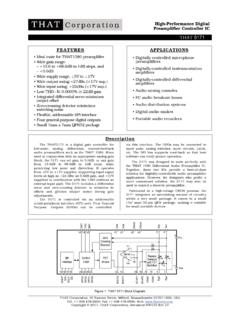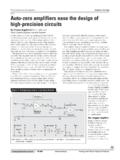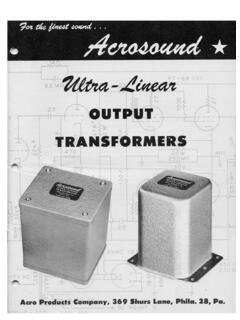Transcription of Basic Compressor / Limiter Design
1 The circuits within this application note feature THAT218x to provide the essential function ofvoltage-controlled amplifier (VCA) and THAT 2252 as an rms-level detector (RMS). Since writingthis note, THAT has introduced a new dual VCA, as well as several Analog Engines . AnalogEngines combine a VCA and am RMS with optional opamps in one With minor modifica-tions, these newer ICs are generally applicable to the designs shown herein, and may offer advan-tages in performance, cost, power consumption, etc., depending on the Design requirements. Weencourage readers to consider the following alternatives in addition to the 218x and 2252: Analog Engine (VCA, RMS, opamps): 4301 Analog Engine with low supply voltage and power consumption (VCA, RMS, opamps): 4320 Analog Engine with low cost, supply voltage, and power consumption (VCA, RMS): 4315 Analog Engine with low cost and power consumption (VCA, RMS): 4305 Dual (VCA only): 2162 For more information about making these substitutions, please contact THAT Corporation'stechnical support group at Note 00A(formerly Application Note 100A)THAT Corporation; 45 Sumner Street, Milford, Massachusetts 01757-1656.
2 USATel: +1 (508) 478-9200; Fax: +1 (508) 478-0990; Web: ; Email: 2009, THAT Corporation; All rights reserved. Document 600135 Revision 01 BasicCompressor / LimiterDesignTHAT Corporation; 45 Sumner Street; Milford, Massachusetts 01757-1656; USATel: +1 (508) 478-9200; Fax: +1 (508) 478-0990; Web: 2009, THAT Corporation; Document 600135 Rev 01 THATC orporationDesign Note 00A(formerly Application Note 100A) Basic Compressor / Limiter DesignAbstractTHAT Corporation s 2252 RMS-Level Detectorand2180/2181 SeriesVoltage-Controlled Ampli-fiers (VCAs) are ideal Basic building blocks forcompressor/ Limiter designs. This application notedescribes in detail the circuitry for two Basic com-pressor/ Limiter designs using these ,hard-knee Compressor with variable ratio, thresh-old and gain controls.
3 The second Design adds asoft-knee threshold. Suggestions for alignment arepresented, as are ideas for modifying the Basic cir-cuits to allow common Compressor / Limiter DesignThis application note describes how to useTHAT Corporation s 2252 RMS-Level Detector and2180 / 2181 Series Voltage-Controlled Amplifiers tomake Basic above-threshold the text, it is assumed that the readerhas become familiar with the Basic application ofthese devices. For additional information on theoperation of the devices themselves, please refer tothe 2252 and 2180 / 2181 Series data THAT 2252 RMS-Level Detector and 2180 /2181 Series Voltage-Controlled Amplifier (VCA),makes an ideal detector/controller pair for audiocompressor/ Limiter designs.
4 The 2252 provides adc output in logarithmic (decibel-scaled) format,while a 218X (2180A / 2181A, 2180B / 2181B and2180C / 2181C) accepts gain control commands inexponential format (also decibel-scaled). The com-bination of a 2252 detector and a 218X VCA makesit possible to construct a variety of compressorsand/or limiters with unprecedented ease, freeingthe Design engineer to concentrate on the functionalre quirements of a Design , rather than on the meth-ods to achieve this CompressorFigure 1, Page 2, shows a Basic above-thresholdcompressor utilizing a 2252 detector and a 218 XVCA. This Design offers independent control overthreshold, compression ratio, and after compres-sion gain.
5 Time constants are handled automati-cally by the 2252. The Design exploits the highlypredictable behavior of the 2252 and 218X to makepossibleasimple,effectiveandversatil efeedforward approach to gain control. (For a math-ematical analysis of this class of circuit, seeAN101A,The Mathematics of Log-Based Dy-namic Processors, also available from THAT Cor-poration.)Signal PathThe audio signal flows only through the 218 Xand OA1, making the signal path short enough tolocate it entirely around the input and output jackson the PC board. Input signals are coupled to the218X through C1and R1.
6 Since the input of the218X is a virtual ground, R1determines thestrength of the input (current) to the 218X. The 20kresistor shown is optimum for input voltages of upto about 10 VRMS, or +20 (along with R1) sets the low-frequency limit inthe signal path()fRCC=1211p. As shown, the-3 dB corner is at about 218X produces an output current signal inpin 8 which is a replica of the input signal, scaled(in decibels) by the voltage at pin 3. OA1convertsthis current back to a voltage based on its feedbackresistor, , as shown, VIN=VOUT whenever pin 3 (the control port) is at 0 V (this isunity, or 0 dB gain). For every 6 mV increase in thevoltage at pin 3, the gaindecreasesby1dB.
7 Forevery 6 mV decrease in voltage, the gainincreasesby 1 dB. Therefore, the output signal level dependsonly on the input signal and the control voltage ap-plied to pin DetectorThe input signal is also applied to the 2252 rms de-tector through C3and R7(like the 218X, the 2252 s in-put is a virtual ground). In this circuit, the 2252 isconfigured to provide 0 V at its output (pin 7) when ap-proximately 316 mV rms (-10 dBV) is present at thecircuit input. As the input signal varies, the 2252 s out-put voltage will vary. For each 1 dB of increase in inputlevel, its output increases by 6 mV. Every 1 dB decreasein input causesa6mVdecrease in dc the ThresholdThe output of the 2252 is connected to OA2, whichis configured as an inverting, half-wave operational rec-tifier.
8 Neglecting the effect of R16and R17, when VRMS isnegative, the output of OA2will be positive, and D2blocks this voltage from reaching VTH. Therefore, VTH=0 for VRMS< 0. However, when VRMSis positive, theoutput of OA2goes negative, and VTHfollows VRMS witha gain of 1. Therefore, VTH= VRMSfor VRMS> the effects of R16and R17,OA2and its as-sociated circuitry only passes information when the in-put signal is above the input level which causes VRMS=0 V (thethreshold). No information passes for signalsbelow this threshold. The transition from below toabove threshold is sharp, because the operational recti-fier used as the threshold detector linearizes the di-ode s exponential V-I R16provide a means of adjusting the thresh-old.
9 For supply rails of 15 V, R17adjusts the thresh-old over 182 mV (from()VRR+1816to()VRR-1816),equivalent to 30 dB at 6 mV/dB. With the wiper of R17towards V+, VTHwill respond for any VRMS> -182 mV,or VIN> -40 dBV. With the wiper of R16towards V-, VTHwill respond for VRMS> +182 mV, or VIN> adjusts the threshold over the range +20 dBV to-40 that a linear-taper potentiometer should beused for R17, the THRESHOLD control. This is becausethe signal at the 2252 output represents the log of theinput signal level it has already been converted todecibels. A linear change in threshold voltage corre-sponds to a linear change in decibel represents the decibel level of the in-put signal above THRESHOLD.
10 See Figure 2, Page 3 forTHAT Corporation; 45 Sumner Street; Milford, Massachusetts 01757-1656; USATel: +1 (508) 478-9200; Fax: +1 (508) 478-0990; Web: 2009, THAT Corporation; All rights 600135 Rev 01 Page 2 of 6 Design Note 00 ABasic Compressor / Limiter Design +-OA1+-OA2+-OA3R16D2R1C1R2R6C2R22C 3R7R8R9R10R11 RTC41R13R12R14R18R20R23R17C5D1 CTR5R4R211R19218X2252 OUTINV-V+V-V-V-V+V-V+V-V+V-V+V-V+RATIO CONTROLTHRESHOLD DETECTORRMS DETECTORSIGNAL PATHEc+Ec+Ec-OUT-INV-GNDV+V+OUTCAPV-SYMG NDIBIASIN63k4150ksymVCA1u1k2k0 1%2k0 1%5. All opamps 55322M21464K243k165k10u1%1%1%1%1%4. V+ = +15V, V- = -15V2. All Capacitors 10%42863517813742652k0 1%-20+20-40+202k0 1%47k24k10uGAINTHRESHOLDCOMPRESSION22p NPO3.

















